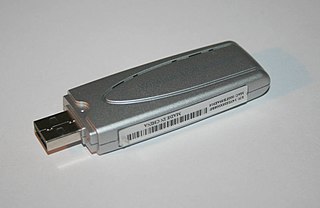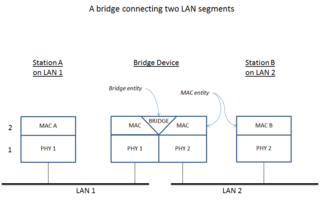External links
| | This computer networking article is a stub. You can help Wikipedia by expanding it. |
IEEE 802.11c is an amendment to the IEEE 802.1D MAC bridging standard to incorporate bridging in wireless bridges or access points. This work is now part of IEEE 802.1D-2004.
802.11c was ratified in October 1998 and is a supplement to IEEE 802.1D that adds requirements associated with bridging 802.11 wireless client devices. In particular it adds a sub clause under 2.5 Support of the Internal Sublayer Service, to cover bridge operations with 802.11 MACs.
IEEE 802.15 is a working group of the Institute of Electrical and Electronics Engineers (IEEE) IEEE 802 standards committee which specifies Wireless Specialty Networks (WSN) standards. The working group was formerly known as Working Group for Wireless Personal Area Networks.

IEEE 802 is a family of Institute of Electrical and Electronics Engineers (IEEE) standards for local area networks (LANs), personal area networks (PANs), and metropolitan area networks (MANs). The IEEE 802 LAN/MAN Standards Committee (LMSC) maintains these standards. The IEEE 802 family of standards has had twenty-four members, numbered 802.1 through 802.24, with a working group of the LMSC devoted to each. However, not all of these working groups are currently active.

IEEE 802.11 is part of the IEEE 802 set of local area network (LAN) technical standards, and specifies the set of medium access control (MAC) and physical layer (PHY) protocols for implementing wireless local area network (WLAN) computer communication. The standard and amendments provide the basis for wireless network products using the Wi-Fi brand and are the world's most widely used wireless computer networking standards. IEEE 802.11 is used in most home and office networks to allow laptops, printers, smartphones, and other devices to communicate with each other and access the Internet without connecting wires. IEEE 802.11 is also a basis for vehicle-based communication networks with IEEE 802.11p.

A wireless LAN (WLAN) is a wireless computer network that links two or more devices using wireless communication to form a local area network (LAN) within a limited area such as a home, school, computer laboratory, campus, or office building. This gives users the ability to move around within the area and remain connected to the network. Through a gateway, a WLAN can also provide a connection to the wider Internet.

Wi-Fi is a family of wireless network protocols based on the IEEE 802.11 family of standards, which are commonly used for local area networking of devices and Internet access, allowing nearby digital devices to exchange data by radio waves. These are the most widely used computer networks, used globally in home and small office networks to link devices and to provide Internet access with wireless routers and wireless access points in public places such as coffee shops, hotels, libraries, and airports.
The Spanning Tree Protocol (STP) is a network protocol that builds a loop-free logical topology for Ethernet networks. The basic function of STP is to prevent bridge loops and the broadcast radiation that results from them. Spanning tree also allows a network design to include backup links providing fault tolerance if an active link fails.

In IEEE 802 LAN/MAN standards, the medium access control (MAC), also called media access control, is the layer that controls the hardware responsible for interaction with the wired or wireless transmission medium. The MAC sublayer and the logical link control (LLC) sublayer together make up the data link layer. The LLC provides flow control and multiplexing for the logical link, while the MAC provides flow control and multiplexing for the transmission medium.
IEEE 802.11i-2004, or 802.11i for short, is an amendment to the original IEEE 802.11, implemented as Wi-Fi Protected Access II (WPA2). The draft standard was ratified on 24 June 2004. This standard specifies security mechanisms for wireless networks, replacing the short Authentication and privacy clause of the original standard with a detailed Security clause. In the process, the amendment deprecated broken Wired Equivalent Privacy (WEP), while it was later incorporated into the published IEEE 802.11-2007 standard.
IEEE 802.1Q, often referred to as Dot1q, is the networking standard that supports virtual local area networking (VLANs) on an IEEE 802.3 Ethernet network. The standard defines a system of VLAN tagging for Ethernet frames and the accompanying procedures to be used by bridges and switches in handling such frames. The standard also contains provisions for a quality-of-service prioritization scheme commonly known as IEEE 802.1p and defines the Generic Attribute Registration Protocol.
IEEE 802.11r-2008 or fast BSS transition (FT), is an amendment to the IEEE 802.11 standard to permit continuous connectivity aboard wireless devices in motion, with fast and secure client transitions from one Basic Service Set to another performed in a nearly seamless manner. It was published on July 15, 2008. IEEE 802.11r-2008 was rolled up into 802.11-2012. The terms handoff and roaming are often used, although 802.11 transition is not a true handoff/roaming process in the cellular sense, where the process is coordinated by the base station and is generally uninterrupted.

A wireless network interface controller (WNIC) is a network interface controller which connects to a wireless network, such as Wi-Fi, Bluetooth, or LTE (4G) or 5G rather than a wired network, such as an Ethernet network. A WNIC, just like other NICs, works on the layers 1 and 2 of the OSI model and uses an antenna to communicate via radio waves.

A network bridge is a computer networking device that creates a single, aggregate network from multiple communication networks or network segments. This function is called network bridging. Bridging is distinct from routing. Routing allows multiple networks to communicate independently and yet remain separate, whereas bridging connects two separate networks as if they were a single network. In the OSI model, bridging is performed in the data link layer. If one or more segments of the bridged network are wireless, the device is known as a wireless bridge.
802.11j-2004 or 802.11j is an amendment to the IEEE 802.11 standard designed specially for Japanese market. It allows wireless LAN operation in the 4.9–5.0 GHz band to conform to the Japanese rules for radio operation for indoor, outdoor and mobile applications. The amendment has been incorporated into the published IEEE 802.11-2007 standard.
IEEE 802.1D is the Ethernet MAC bridges standard which includes bridging, Spanning Tree Protocol and others. It is standardized by the IEEE 802.1 working group. It includes details specific to linking many of the other 802 projects including the widely deployed 802.3 (Ethernet), 802.11 and 802.16 (WiMax) standards.
Multiple Registration Protocol (MRP), which replaced Generic Attribute Registration Protocol (GARP), is a generic registration framework defined by the IEEE 802.1ak amendment to the IEEE 802.1Q standard. MRP allows bridges, switches or other similar devices to register and de-register attribute values, such as VLAN identifiers and multicast group membership across a large local area network. MRP operates at the data link layer.
IEEE P802.1p was a task group active from 1995 to 1998, responsible for adding traffic class expediting and dynamic multicast filtering to the IEEE 802.1D standard. The task group developed a mechanism for implementing quality of service (QoS) at the media access control (MAC) level. Although this technique is commonly referred to as IEEE 802.1p, the group's work with the new priority classes and Generic Attribute Registration Protocol (GARP) was not published separately but was incorporated into a major revision of the standard, IEEE 802.1D-1998, which subsequently was incorporated into IEEE 802.1Q-2014 standard. The work also required a short amendment extending the frame size of the Ethernet standard by four bytes which was published as IEEE 802.3ac in 1998.
IEEE 802.1ad is an amendment to the IEEE 802.1Q-1998 networking standard which adds support for provider bridges. It was incorporated into the base 802.1Q standard in 2011. The technique specified by the standard is known informally as stacked VLANs or QinQ.
IEEE 802.11ac-2013 or 802.11ac is a wireless networking standard in the IEEE 802.11 set of protocols, providing high-throughput wireless local area networks (WLANs) on the 5 GHz band. The standard has been retroactively labelled as Wi-Fi 5 by Wi-Fi Alliance.
IEEE 802.11k-2008 is an amendment to IEEE 802.11-2007 standard for radio resource measurement. It defines and exposes radio and network information to facilitate the management and maintenance of a mobile Wireless LAN. IEEE 802.11k was incorporated in IEEE Std 802.11-2012; see IEEE 802.11.
IEEE 802.11ay, Enhanced Throughput for Operation in License-exempt Bands above 45 GHz, is a follow-up to IEEE 802.11ad WiGig standard which quadruples the bandwidth and adds MIMO up to 8 streams. Development started in 2015 and the final standard IEEE 802.11ay-2021 was approved in March 2021.